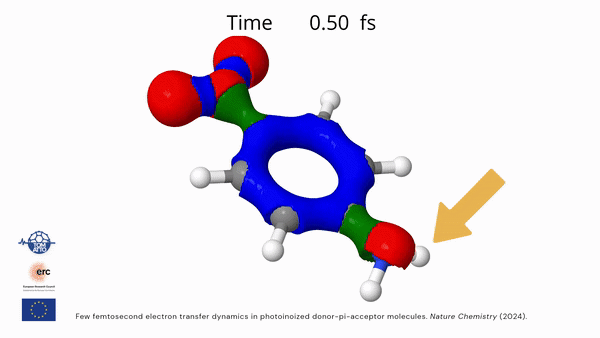Reviewed by Danielle Ellis, B.Sc.Sep 26 2024
Researchers from IMDEA Nanociencia used attosecond extreme-ultraviolet press in a study published in Nature Chemistry to reveal new insights into the ultrafast dynamics of molecular systems. This groundbreaking work greatly advances comprehension of chemical processes at the most fundamental level by providing a novel viewpoint on the intricate interaction between electrons and nuclei in donor-acceptor molecules.
 Simulation of electronic density in a para-nitroaniline molecule after photoexcitation (animation). Image Credit: Fernando Martín.
Simulation of electronic density in a para-nitroaniline molecule after photoexcitation (animation). Image Credit: Fernando Martín.
Photovoltaics in solar panels convert light into electrical energy, just as photosynthesis does in plants and microbes. These mechanisms suggest molecular charge transfer and are propelled by electronic motion. After molecules absorb light, their electronic density redistributes.
This ultrafast event, which involves both quantum effects and molecular dynamics, is very significant. In addition to offering a fundamental understanding of the physical mechanisms underlying these processes, the ability to measure the electron and charge transfer dynamics with extreme temporal resolution also provides novel insights into how to engineer the chemical and structural properties of the molecule to control or enhance them.
Using ultrashort ultraviolet pulses, which can range from the femtosecond (10–15 seconds) to the attosecond (10–18 seconds), high-order harmonic sources or free electron laser facilities are effective means of causing photoionization in molecules and tracking its reaction. Although these methods have advanced significantly, a thorough comprehension of the first phases of electron and charge transfer following fast photoionization is still lacking.
The research team has achieved unparalleled precision in observing and analyzing the initial steps of charge transfer by subjecting nitroaniline molecules to attosecond pulses. This research used a variety of state-of-the-art methods, such as sophisticated many-body quantum chemistry computations and attosecond extreme-ultraviolet-pump/few-femtoseconds infrared-probe spectroscopy, to capture the dynamics of these rapid processes.
The several phases of the electron and charge transfer process have all been covered in detail, including precise time information. Important discoveries from the study show that electron transfer from the electron donor amino group is fueled by a coordinated movement of nuclei and electrons and happens in less than 10 fs.
Subsequently, a sub-30 fs timescale relaxing process occurs when the nuclear wave packet disperses throughout the molecule cation's excited electronic states. These findings provide important new understandings of the effects of photoionization on electron donor-acceptor systems influenced by electron-nuclear coupling.
The data presented here reveal the timeframes needed to transfer charge from an electron donor unit to the nearby chemical bond connecting that unit with a benzene ring and the corresponding necessary structural changes that occur. These data provide an answer to a key subject in chemistry.
According to the authors, theoretical and experimental results can help us better understand the concepts and textbook diagrams used to qualitatively forecast charge migration in organic molecules.
This work not only clarifies the complexities of molecular dynamics but also paves the way for further investigations that will enhance comprehension of attosecond science from a theoretical and practical standpoint.
The Outcome of an ERC Synergy Grant
The goal of the ambitious scientific project TomATTO is to increase the efficiency with which solar energy is converted by capturing the ultrafast dynamics of electrons. According to the researchers, the efficiency of solar cells, which presently only manage to convert less than 25% of the solar energy that reaches them, could be increased by monitoring, comprehending, and managing the excitation of molecules in these devices.
Three main obstacles will be addressed by TomATTO researchers during the project's six-year duration: 1) documenting the first electronic processes brought about by light absorption; 2) creating novel organic materials to regulate electronic dynamics; and 3) creating computational techniques to interpret the findings.
In pursuit of this goal, the research team of the TomATTO consortium unites in this synergistic initiative under the direction of professors Fernando Martín (IMDEA Nanociencia, Universidad Autónoma de Madrid), Nazario Martín (Universidad Complutense de Madrid), and Mauro Nisoli (Polytechnic Institute of Milan).
The European Research Council (ERC Synergy) provides €12 million in financing for the TomATTO project, which is coordinated by IMDEA Nanociencia.
Researchers from Politecnico di Milano (Italy), the Madrid Institute for Advanced Studies in Nanoscience (IMDEA Nanociencia, Spain), Universidad Autónoma de Madrid (Spain), IMEC (Leuven), Complutense University of Madrid (Spain), Istituto di Struttura della Materia (Rome), and Sincrotrone Trieste (Italy) collaborated on this project to produce this work.
The ERC Synergy Grant TOMATTO to the professors Mauro Nisoli, Fernando Martín, and Nazario Martín; the COST Action ATTOCHEM; and the Excellence Severo Ochoa accreditation to IMDEA Nanociencia have all contributed to the study partially.
Journal Reference:
Vismarra, F., et al. (2024) Few-femtosecond electron transfer dynamics in photoionized donor–π–acceptor molecules. Nature Chemistry. doi.org/10.1038/s41557-024-01620-y.